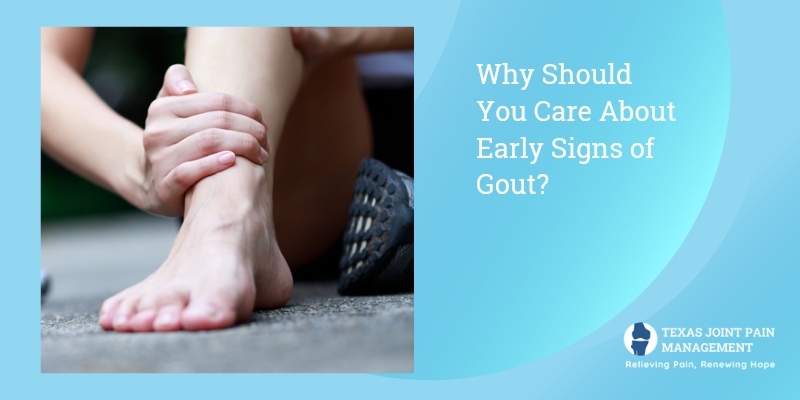What is Gout?
Gout is a complex form of arthritis that brings with it severe pain, redness, and tenderness in joints. It occurs when a large amount of uric acid crystallizes in the joints causing deposition of the same. Pain and inflammation are the most common symptoms of gout and attacks can come suddenly, mostly at night. It affects various joints in the body, but most commonly the big toe.
You should care about early signs of gout to avoid sudden and sudden gout attacks that come with debilitating pain. A gout attack will often wake you up mid-sleep and the intensity of pain is so high that even the weight of a bedsheet could seem intolerable. The symptoms of gout might come and go, but steps should be taken to prevent flares by managing these symptoms. Let us see what are some of the common signs and symptoms of gout.
Signs and Symptoms of Gout
Gout can be asymptomatic, acute, or chronic.
When someone has a high concentration of uric acid in their blood but no signs of gout are evident, it is known as asymptomatic gout.
In the acute case of gout, symptoms can be seen quickly with the uric acid build-up and might last for three to ten days.
Gout becomes chronic when it is left untreated. In such cases, hard lumps called ‘tophi’ are developed in joints and the skin tissues surrounding the affected joints. These tophi can permanently damage the joint.
What is the first sign of gout?
The first signs of gout include intense pain and swelling in the joint with a warm feeling in the area. There are no symptoms in between the gout attacks.
Other symptoms to keep an eye for gout are:
- Joint Pain: Gout mostly affects the big toe of the foot but other commonly affected joints are knees, elbows, finger joints, wrists, and ankles.
- Inflammation and Redness: The joints affected by gout become tender and red and feel warm and swollen.
- Limited motion: The motion of the affected joint is hampered as gout progresses.
- Lasting pain: Even when the effects of the gout attack subside, you might feel a lingering discomfort in the affected joints for many days that might go up to a few weeks.
Gout that is not treated correctly and on time might lead to permanent joint damage and chronic pain conditions. It is important to identify early signs of gout in toe, feet, ankle, wrist, or any other joint to consult with the doctor immediately. See your doctor when:
- You experience sudden debilitating pain in any joint.
- You have a fever and the affected joint is inflamed, hot, and throbbing.
If your uric acid levels are high, keep an eye for:
- Signs of gout in the toe
- Signs of gout in feet
- Signs of gout in the ankle
- Signs of gout in the knee
- Signs of gout in the wrist
- Signs of Gout in finger joints
- Consult your doctor if you are taking medication that increases your risk of gout
What Causes Gout?
Gout occurs with the accumulation of urate crystals in your joints as a result of high levels of uric acid in the blood. The body produces uric acid while breaking down purines that are naturally found in the body and in certain food items such as:
- Red meat and organ meat
- Seafood such as anchovies, sardines, mussels, scallops, trout and tuna
- Alcoholic beverages such as beer
- Non-alcoholic beverages with fructose
Uric acid usually dissolves in the blood and passes out of the body into your urine. Sometimes the body produces too much uric acid, or the kidneys excrete too little uric acid. In such conditions, uric acid can build up and form needle-like urate crystals in joints.
Prevention of Gout
Gout can be prevented by controlling the uric acid level in the body. Some of the steps to prevent gout are:
- Limit alcohol consumption
- Limit consumption of food items rich in purine such as shellfish, beef, lamb, pork, and organ meat
- Consume low-fat and non-dairy food items
- Follow a diet that is rich in vegetables
- Lose excess weight by exercising
- Stay hydrated
- Quit smoking
Apart from the regular care, timely take the medicines that are prescribed by the doctor for a gout flare-up. Other non-medical methods for pain relief are:
- Use cold compresses or cool packs on the affected joints for 20 minutes to lower the inflammation and soothe the pain. Make a homemade ice pack by wrapping ice in a thin towel. Be careful while using ice on your hands and feet in case you have nerve problems.
- Rest the joint until the pain eases up and limit movement of the affected joint. Raise the joint on a soft object such as a pillow for comfort.
- Consume a large quantity of water when the uric acid levels rise higher. Staying hydrated will help in keeping these levels normal.
- Keep a tab on what you eat and drink.
When to See the Doctor?
When experiencing gout-like symptoms or having a flare, it is always safer to consult the doctor straight away. If you already are pursuing a treatment plan, it is wise to follow up to make sure the treatment plan is working. Also, call your doctor in the following scenarios:
- When you encounter your first flare-up or if you experience joint infection like symptoms
- If you have a mild or high fever and chills along with joint pain
- If the symptoms do not get better after 48 hours or a maximum a week
Most of the time gout attack is relieved by itself. Consulting a specialist and taking proper treatment should be your first instinct when experiencing gout.

